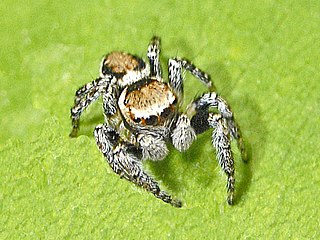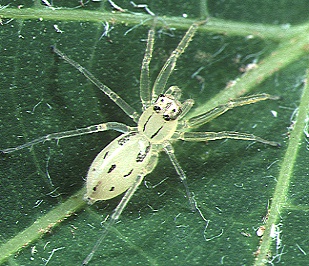
The yellow-tail, goldtail moth or swan moth is a moth of the family Erebidae. The species was first described by Johann Kaspar Füssli in 1775, and has commonly been placed within the related genus Euproctis. It is distributed throughout Europe to the Urals, then east across the Palearctic to Siberia and south to India and Sri Lanka.

Helophilus pendulus is a European hoverfly. Its scientific name means "dangling marsh-lover". It is a very common species in Britain, where it is the commonest Helophilus species. It is found throughout Europe from the Mediterranean to Scandinavia, westward to the Faroe Islands and Iceland, and through eastward through Russia from the Kola Peninsula south to Crimea and across Siberia to the Pacific Ocean.

Evarcha falcata is a species of 'jumping spiders' belonging to the family Salticidae.

The Manipur bush rat, also known as Hume's rat or Hume's hadromys, is a species of rodent in the family Muridae. It is found in northeastern India, and is listed as endangered.

The yellow-pine chipmunk is a species of order Rodentia in the family Sciuridae. It is found in western North America: parts of Canada and the United States.

White's skink, also known commonly as White's rock skink, is a species of lizard in the family Scincidae. The species is endemic to Australia.

Toxomerus politus, commonly known as the maize calligrapher, is a species of hoverfly. It is known from North, Central and South America. Although little is known about the early stages of this species, associations with corn have been noted. The adults and likely the larvae feed on the pollen of the corn plants.

Chrysotoxum pubescens the Yellow-throated Meadow Fly is a North American species of syrphid fly in the family Syrphidae.The adults are strong mimics of wasps. Larvae of this species has been described.

Langona manicata is a species of jumping spider in the genus Langona that lives in South Africa. The spider was first described by Eugène Simon in 1901. It is large, between 6 and 38 mm long, the female larger than the male. The female has a white-grey cephalothorax with a stripe down the middle while the male has a black cephalothorax. The female also has a stripe of its abdomen, which the male lacks. It is hard to differentiate from other Langona spiders, particularly Langona avara. The main distinguishing characteristic is the colour of the hairs on the single apophysis on the male pedipalp.
Mogrus cognatus is a species of jumping spider in the genus Mogrus that lives in United Arab Emirates and Yemen. The spider was first defined in 1994 by Wanda Wesołowska and Anthony Van Harten. It is a small spider. The male has a dark brown or fawn-brownish carapace that range between 2.6 and 2.8 mm long and a yellow-white or dark brown abdomen between 2.7 and 3.1 mm long. The female has not been described. The spider is similar to the related Mogrus fulvovittatus, but can be distinguished by its copulatory organs. It has a long thin embolus that encircles the palpal bulb and has a distinctive membane at its base.

Helophilus fasciatus, the narrow-headed marsh fly, is an abundant species of syrphid fly observed throughout the United States and Canada. Hoverflies can remain nearly motionless in flight. The adults are also known as flower flies for they are commonly found on flowers, from which they get both energy-giving nectar and protein-rich pollen. The larvae of this genus are associated with wet decaying organic material, particularly accumulations of decaying vegetation in ponds and mud and farmyard manure or silage. The adults of this species lays eggs on vegetation overhanging the water. The larvae hatch and drop into the water.

Aelurillus dubatolovi is a species of jumping spider in the genus Aelurillus that lives in Central Asia. First identified in 2003 in Turkmenistan, it has a distribution that extends from Caspian Sea to Lake Balkhash and includes Kazakhstan, Kyrgyzstan, Tajikistan and Uzbekistan. The spider itself is small, the male being smaller than the female, with a carapace measuring between 3.1 and 3.6 mm in length and an abdomen between 2.9 and 4.1 mm long. The carapace is dark brown, with long hairs along the side that distinguish the species from the similar Aelurillus brutus and Aelurillus lutosus. It also has a hairy clypeus and palpal femora, which enables it to be identified as not being the otherwise similar Aelurillus ater. The female has a net-like pattern on the abdomen. This is clearer on examples found towards the northeast of the species distribution. The spiders found towards the northeast are also smaller, lighter and less hairy, but these are insufficient differences to identify them as a different species.

Asemonea tanikawai is a species of jumping spider in the genus Asemonea that is endemic to Japan. It lives in trees in mountain ranges. The spider was first described in 1996 by Hiroyoshi Ikeda. The spider is small, with a carapace [prosoma that between 1.31 and 1.60 mm long and an abdomen is between 1.84 and 2.24 mm long. It is whitish-yellow with a pattern of two brown stripes down the back of the carapace and nine black dots on the back of the abdomen. The male has a distinctive pedipalp with a complex tibial apophysis and a furrow alongside the femoral apophysis, which distinguishes it from the otherwise similar Asemonea maculata and Asemonea pinangensis. The female is also similar, with its copulatory openings hidden in its epigyne. The spider has been found throughout Okinawa and the other Ryukyu Islands.

Blera badia, the Common Wood Fly, is a common species of syrphid fly first officially described by Walker in 1849. Hoverflies get their names from the ability to remain nearly motionless while in flight. The adults are also known as flower flies, for they are commonly found around and on flowers, from which they get both energy-giving nectar and protein-rich pollen. The larvae are of the rat-tailed type, feeding on exuding sap or in the rot holes of trees.
Andrenosoma fulvicaudum is a species of robber fly in the family Asilidae. It was first formally named as Laphria fulvicauda by Thomas Say in 1823. The type specimen was from Missouri, but was lost.

Helophilus obscurus , the Obscure Marsh Fly, is a common species of syrphid fly observed throughout Canada and the northern United States and Rocky Mountains. Hoverflies can remain nearly motionless in flight. The adults are also known as flower flies for they are commonly found on flowers, from which they get both energy-giving nectar and protein-rich pollen. The larvae of this genus are associated with wet decaying organic material, particularly accumulations of decaying vegetation in ponds and mud and farmyard manure or silage the larvae of this species are not known.

Choerades marginata is a species of robber fly found in Europe.

Ascalaphus is a genus of owlfly belonging to the tribe Ascalaphini. The species of this genus are found in Africa and Asia.

Chrysotoxum baphyrum is a species of holarctic hoverfly. The adults are strong mimics of wasps. Larvae of this genera, when known, are aphid predators.

Trabala pallida is a species of moth in the family Lasiocampidae. They can be found from Southeast China, south throughout Thailand and most of Sundaland. One subspecies is Trabala pallida montana.


















